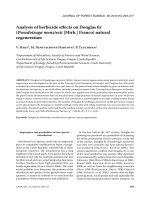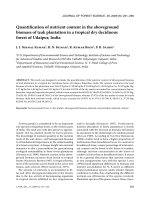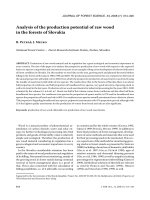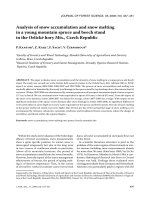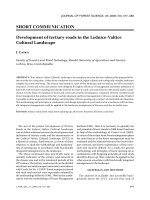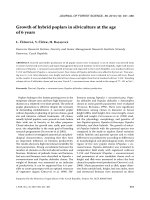Báo cáo lâm nghiệp: "Analysis of some dynamic series of forest production and trends of forest economics in the Czech Republic" ppt
Bạn đang xem bản rút gọn của tài liệu. Xem và tải ngay bản đầy đủ của tài liệu tại đây (253.05 KB, 10 trang )
J. FOR. SCI., 53, 2007 (3): 119–128 119
JOURNAL OF FOREST SCIENCE, 53, 2007 (3): 119–128
Forest production has recently become an im-
portant factor of the socio-economic development
of society and there are ever greater expectations
that the forest will also meet a certain standard with
respect to multi-purpose management. However, to
simultaneously meet all requirements and demands
imposed on the forests depends to a certain extent
on the creation of profit from timber sales (accord-
ing to 2001 Report on the Condition of Forests and
Forestry in the Czech Republic).
In general, wood-producing functions express
a maximum achievable production volume at the
effective use of available production factors – re-
sources. e investigation of production functions
is one of the basic tasks of economics as a scientific
discipline, namely of its application – i.e. economics
at national, sectoral and corporate levels.
In the conditions of forestry the wood-producing
function [e division of forest functions into wood-
producing and non-wood-producing functions is
laid down in § 2 of the Forest Act currently in force.
e Forest Act also contains the specification of for-
est functions expressed by means of the forest cate-
gorization (§ 7, § 8) which classifies forests according
to their prevailing functions into the categories of
protection forests, special-purpose forests and com-
mercial forests.] is historically determined by felling
possibilities of forest resources with the achieved
revenues from timber sales having demarcated from
time immemorial in a complementary way the space
for the implementation of silvicultural operations
and hence the forest future. However, the two deter-
minations have recently developed dynamically and
adversely affected each other – both with respect to
the development of commercial forest production
and in terms of the implementation of the strategy
of sustainable life and application of principles of
near-natural forest management methods (K
2005).
According to B (1994), the production of
forestry is a complex of produced and assured utility
values, i.e. products and services; the term however
includes also non-productive services ensuring non-
wood-producing functions of the forest. e reason
Supported by the Czech Science Foundation, Project No. QF 3233.
Analysis of some dynamic series of forest production
and trends of forest economics in the Czech Republic
V. K
Faculty of Forestry and Wood Technology, Mendel University of Agriculture and Forestry Brno,
Brno, Czech Republic
ABSTRACT: Functions of wood production in forestry are historically determined by felling possibilities of forest
resources. Revenues from timber sales create a financial space for silvicultural operations thus providing for manage-
ment continuity. ese determinations have however recently shown a rather negative trend of development due to
the development of timber prices on the one hand and due to increasing inputs on the other hand, last but not least
also due to the projections of near-natural forest management methods and increasing area under special management
regimes. In their synergy, all these factors lead to economic impacts reflected not only in the profit of forest owners but
also in economic results of other entities. e paper presents an analysis into the trends of forest management primary
economic variables in the Czech Republic in the period from 1998–2004.
Keywords: production in forestry; economics of forest management; dynamic (time) series; trend
120 J. FOR. SCI., 53, 2007 (3): 119–128
is that the two activities mostly cannot be matter-of-
factly and in terms of values properly distinguished,
and for the non-wood-producing functions of the
forest also due to the fact that they are provided to
their users (community) by forestry free of charge.
Costs of their reproduction are included at a decisive
measure in the costs of material production (mainly
timber production) with the exception of state par-
ticipation in the process of reallocation (e.g. in the
form of subsidies and supports to forest owners).
e issue of assessing the wood-producing and
non-wood-producing significance of the forest for
the society is very complicated not only due to the
fact that the forest itself is a complex object with
many-sided effects for the society but also because
the forest and the system of its utility values have
continually developed along with the development
of society’s needs. us the expression of the social
significance of forest functions becomes a socio-
economic category and as such a component part of
social sciences, namely economic and sociological
disciplines (Š et al. 2003).
Apart from the forest production “for the owner”,
timber production has a broader economic and so-
ciological context that may reach as far as the frame-
work of raw-material policy of national economy
(including energy policy).
In the Czech Republic forestry belongs to the sector
of the Ministry of Agriculture (MZe ČR, 16,000 Sec-
tion of Forestry and Water Management, 16,200 De-
partment of Forestry). According to the status
ranking of industries and their economic activities
(NACE) it belongs to Section A Agriculture, game
management, forestry; Sub-section 02 – Forestry
and related activities. e position of forestry within
the national economy is expressed by means of mac-
roeconomic indicators the most important of which
are indicators of the creation of gross national prod-
uct (GNP) and forestry’s share in it, more recently
the share of the industry in the value added, indica-
tors of employment and wages, etc.
e share of forestry in the creation of GNP in
the Czech Republic is based on the natural condi-
tions, economic measures in forestry and on the
country’s industrial potential. e main reason for
a relatively low share (0.6–0.7%) and hence low
quantified benefits of forestry for national economy
consists in the hitherto unresolved issue of appraisal
of the above-mentioned non-wood-producing, all-
society forest functions and their ranking in the
economic environment. e potential significance
of forestry for the national economy is increasing
by virtue of the supplier of ecological raw material
from the renewable natural resource – timber, both
for manufacturing industries (wood-processing
industry, paper and pulp industry) and as a source
of energy. The interconnection of forestry with
rural development acquires an ever greater socio-
economic significance within the European Union
while to meet all social demands and requirements
imposed on the forests in fact depends only on tim-
ber felling and sales.
Increment and allowable cut are the determinant
production variables in forestry. Increment, as a dy-
namic indicator, is to express the change of growth
variables within the function of growth. Productiv-
ity of forests (and also for a comparison with felling
possibilities) is most frequently expressed by total
mean increment. Allowable cut is to express the re-
sulting volume of timber that can be extracted from
the forest in the given period of time with respect to
the sustainability and continuity of felling and taking
into account the current division of forests, namely
into age categories.
Regarding the supranational significance of forests
there are new ecological approaches applied in using
their produce e.g. by means of forest certification but
also through the certification of linked manufactur-
ing industries – consumer chains, which however
induces further costs.
e outlined circumstances clearly show an urgent
need to analyze production functions of forests –
their hitherto development and prediction of future
prospects. In these intentions the paper will discuss
some dynamic series of forest production and their
trends including official production characteristics
of timber felling and forest regeneration, being par-
ticularly focused on the analysis of hierarchy and
trends of primary economic variables.
METHODOLOGY
Disposition of data
Data on Czech forestry are based on statistical
surveys guaranteed by the Czech Statistical Office;
some data are provided by Ministry of Agriculture
of the Czech Republic (e.g. by means of annual in-
come statements – statement Forest (MZe) 1-01).
Although it is a complex data set, in fact it is the only
official set of data on forestry, composed of regular
reports on the situation of forests and forestry in the
Czech Republic for the respective years (systemati-
cally since 1996) – so called “Green Reports”.
Primary characteristics analyzed in this paper
were taken over from the above database of reports
on the situation of forests and forestry in the Czech
Republic in order to be further studied in ordered
J. FOR. SCI., 53, 2007 (3): 119–128 121
time and dynamic series according to the character
of variables.
Dynamic (time) series
So called dynamic (time) series are useful statistical
procedures by means of which it is possible to study
mass phenomena in time. ey are also essentially
important for the analysis of causes that affected
these phenomena and influenced their behaviour in
the past, being no less important for predicting their
future development.
e time series is the ordering of observations of a
certain indicator in time – according to the character
and time sequence of the studied variable (feature)
and interval. Studied variables are classified by their
character as extensive and intensive, by the time
interval length as momentary and interval, by the
course of values as periodical and non-periodical,
etc. In addition to current values, the time series
may exhibit variations (such as changes of seasonal
character) or incidental fluctuations (accidental and
irregular effects) (K 2003).
According to S (1988), it is possible to con-
sider three primary types of time series: interval
indicators, momentary indicators, derived charac-
teristics.
Trend and mean coefficient of growth are basic
indicators to express the development of time se-
ries. e trend is to express the course of the vari-
able (indicator) and the basic procedure to detect a
trend is an analytical adjustment of time series, i.e. a
substitution of actual data with a series of theoreti-
cally calculated data or by the replacement of actual
data with a mathematic function. In most cases, the
adjustment is made by means of a linear function,
and by means of an exponential, logistic, cyclic, etc.
function if the course is of non-linear character.
e time series adjustment by means of linear
function can be elementarily expressed by the fol-
lowing relation:
y
i
= a + bt
i
(1)
the exponential trend will be
y
i
= a × b
t
(2)
where:
Σ y
i
Σ y
i
t
i
a = ––––– , b = –––––
n Σ t
i
2
and in the case of mass phenomena
Σ y
i
= n × a + bΣ x
i
(3)
Σ x
i
y
i
= aΣ x
i
+ bΣ x
i
2
(4)
where: y
i
– fitted values for the i-th time period,
a – constant equal to the mean of fitted values,
b – constant specifying the mean change (incre
-
ment, drop) for the time period,
t
i
– time variable for the i-th time period with
Σ t
i
= 0,
y
i
– to-be-fitted values,
n – number of time periods.
Measures of the dynamics of studied phenomena can
be tested by means of elementary indicators – absolute
increment (including mean and relative increments),
mean coefficient of growth, etc. Mean coefficient of
growth (k) is in principle constructed as the n – 1 root
of the series marginal links, or of the trend (marginal
links of fitted time series – k´), where
y
n
y
´
n
k =
n–1
√
––– , k´ =
n–1
√
––– (5)
y
1
y´
1
or more precisely
y
2
y
3
y
n
y
n
k
–
=
n–1
√
k
1
× k
2
k
n
=
n–1
√
–– × –– –– =
n–1
√
–– (6)
y
1
y
2
y
n–1
y
1
Analyses were done of selected technical indica-
tors of the production such as timber felling (total
felling, of this conifers, broadleaved species, felling
intensity) and forest regeneration (total, of this natu-
ral, artificial regeneration). Economic indicators of
particular focus were as follows:
– Mean cost of silvicultural operations (including
forest regeneration, tending of forest plantations,
juvenile thinnings, forest protection);
– Mean cost of logging operations (timber felling,
skidding, haulage, repair and maintenance of
forest roads);
– Revenues from timber sales in the Czech Republic
at current costs including average supply costs
of selected raw timber assortments to domestic
customers;
– Trading income of forest owners (also in the clas
-
sification according to the respective categories of
owners);
– Trading income of business entities engaged in
forestry according to selected activities.
e basic reference period of analyses was con-
structed for 5 years (2000–2004), in economic
indicators for 7 years (1998–2004). Longer time
frameworks are presented in some series of indica-
tors for a better interpretation (namely with respect
to the long-term character of forest activities).
e pivotal informative value of analyses follows
from the tables and diagrams constructed by means
of standard software products.
122 J. FOR. SCI., 53, 2007 (3): 119–128
RESULTS
General production characteristics
of Czech forestry
Primary indicators of forest condition that in a way
predict the forestry size and the intensity of manage-
ment measures are: forest coverage and development
of forest land area, species composition and age
structure of the forests including their categoriza-
tion. Production indicators proper are development
of timber supplies and increments, and consequently
regeneration felling and forest regeneration includ-
ing silvicultural operations as a whole.
e species composition of Czech forests is domi-
nated by conifers – 75.5% (of this Norway spruce
53.2%, pine 17.3%) with the broadleaved species pro-
portion of 23.4% (of this oak 6.5% and beech 6.5%).
e current categorization of Czech forests is as
follows: commercial forests – 75.4%, protection for-
ests – 3.1%, special-purpose forests – 21.6%.
Total timber supplies (timber volumes are report-
ed as the mass of timber to the top of 7 cm outside
bark, i.e. at a minimum diameter of 7 cm) amount
approximately to 658 mil. m
3
with the average stand-
ing volume (mean standing volume per forest stand
area without clearcuts) being about 250 m
3
/ha.
Total mean increment (CPP) is about 17 mil./m
3
per year, which is 6.6 m
3
/ha (according to Report on
the Condition of Forests and Forestry in the Czech
Republic, 2004).
Timber felling
In the whole post-war period, annual timber fell-
ing in the forestry of Czech Republic exhibited an
increasing trend until the mid-1980s (13.91 mil./m
3
in 1985). During the restitution of forest properties
in 1991–1992 it recorded a temporary decrease but
since 1993 the felling volumes have constantly been
increasing and recently exceeded 15 mil./m
3
. e
proportion of coniferous timber ranges around 90%
(of this spruce ca 75%).
Figures of timber felling, felling intensity and total
mean increment per 1 ha forest stand area (CPP) are
presented in Table 1 with the development of timber
felling being illustrated in Fig. 1.
The composition of extracted timber is domi-
nated by roundwood assortments (ca 8 mil./m
3
) and
pulpwood (ca 4.5 mil./m
3
). e remaining supplies
consist of other utility timber products including
chips and fuel wood. e percentage representation
of assortments is as follows: coniferous wood mass:
roundwood 54%, pulp 30%, chips 1% and other as-
sortments 6%; deciduous wood mass: roundwood
43%, pulp 46%, other assortments 11%. e decisive
assortment with an essential influence on the devel-
Table 1. Timber felling and total mean increment
Timber felling Unit 1985 1990 1995 2000 2001 2002 2003 2004
Conifers mil. m
3
12.82 12.17 11.31 12.85 12.68 13.01 13.66 13.92
Broadleaves mil. m
3
1.09 1.16 1.06 1.59 1.69 1.53 1.48 1.68
Total mil. m
3
13.91 13.33 12.37 14.44 14.37 14.54 15.14 15.60
Intensity m
3
/ha forest 5.29 5.07 4.70 5.48 5.45 5.50 5.73 5.90
CPP m
3
/ha forest 6.20 6.30 6.40 6.50 6.50 6.50 6.60 6.60
Source: Ministry of Agriculture of the Czech Republic
0
2
4
6
8
10
12
14
16
18
1985 1990 1995 2000 2001 2002 2003 2004
Year
Conifers Broadleaves Total
Fig. 1. Development of timber felling
(mil. m
3
)
J. FOR. SCI., 53, 2007 (3): 119–128 123
opment of timber prices in the Czech Republic is
roundwood (Rundholz).
Forest regeneration
e long-term development of forest regeneration
according to individual regeneration methods is pre-
sented in Table 2 and Fig. 2. In contrast to the above-
mentioned increasing felling volumes, the area of forest
regeneration shows a decreasing trend despite the
consideration of regeneration methods to be changed
to the benefit of the shelterwood system and natural
regeneration and the known problems of methodology
in recording the natural regeneration (delay).
Table 2. Forest regeneration (ha)
Regeneration method 1985 1990 1995 2000 2001 2002 2003 2004
Artificial 33,555 33,615 30,128 21,867 19,109 17,013 16,481 18,618
– of this repeated 9,569 9,635 12,760 4,371 3,934 3,212 3,284 2,766
Natural
594 908 1,163 3,422 2,956 2,936 2,728 3,401
Total 34,149 34,523 31,291 25,289 22,421 19,949 19,538 22,234
Source: Ministry of Agriculture of the Czech Republic
Table 3. Mean working costs of silvicultural operations (CZK/unit of measure)
Operation – activity Unit 1998 1999 2000 2001 2002 2003 2004
Forest regeneration ha 56,300 59,743 56,724 61,386 58,300 60,074 58,603
Tending of plantations ha 7,005 7,143 7,127 7,444 7,720 7,859 7,964
Juvenile thinnings ha 6,220 6,809 7,221 7,285 7,079 7,597 7,508
Forest protection ha 97 85 89 85 69 128 108
Silvicultural operations in total ha 1,802 1,796 1,757 1,705 1,646 1,639 1,614
Source: Ministry of Agriculture of the Czech Republic
0
5,000
10,000
15,000
20,000
25,000
30,000
35,000
40,000
1985 1990 1995 2000 2001 2002 2003 2004
Year
Artificial Natural Total
0
10,000
20,000
30,000
40,000
50,000
60,000
70,000
1 2 3 4 5 6 7
Year
Forest regeneration
Tending of forest plantations
Juvenile thinnings
Silvicultural operations in total
Fig. 3. Development of costs
of silvicultural operations
(CZK/ha)
Fig. 2. Forest regeneration
development (ha)
Year
Year
124 J. FOR. SCI., 53, 2007 (3): 119–128
Forest economics in the Czech Republic
Analyses into forest economics usually deal with
the situation of forest owners and entrepreneurs
in forestry, most frequently expressed by means of
incurred – so called working costs by respective
activities. However, income from operations (trad-
ing income) is the resulting and central economic
variable at all times.
e structure and development of mean work-
ing costs in selected silvicultural operations are
illustrated in Table 3 and Fig. 3. Analogically, mean
manufacturing costs according to selected felling
operations are presented in Table 4 and Fig. 4.
Although the unit costs grow, the costs of silvi-
cultural operations show an evident continually
decreasing trend in the indicator of total silvicultural
operations per 1 ha of forest (Table 3).
Table 4. Mean working costs of felling operations (CZK/unit of measure)
Operation – activity Unit 1998 1999 2000 2001 2002 2003 2004
Timber felling m
3
141 143 148 154 145 142 160
Skidding m
3
184 196 200 187 202 200 196
Haulage m
3
138 151 149 152 146 162 156
Repair and maintenance of forest roads ha 541 597 510 503 462 429 367
Source: Ministry of Agriculture of the Czech Republic
Table 5. Revenues from timber sales in the Czech Republic in current prices
Indicator Unit 1998 1999 2000 2001 2002 2003 2004
Timber supplies in total mil./m
3
13.99 14.20 14.44 14.37 14.54 15.14 15.60
Marketable production volume mld. CZK 18.58 19.60 20.00 19.68 17.91 18.54 18.50
Mean conversion to money CZK/m
3
1,328 1,380 1,385 1,369 1,232 1,225 1,186
Profit per 1 m
3
of supplies CZK/m
3
86 82 67 77 50 37 19
0
50
100
150
200
250
1998 1999 2000 2001 2002 2003 2004
Year
Timber felling Skidding Haulage
0
100
200
300
400
500
600
700
800
1998 1999 2000 2001 2002 2003 2004
Year
State forests
Municipal forests
Private forests
Average
Fig. 4. Development of unit costs
of felling operations in the Czech
Republic (CZK/m
3
)
Fig. 5. Development of forest owners’
profit before tax (CZK/ha)
Year
J. FOR. SCI., 53, 2007 (3): 119–128 125
Mean unit working costs of logging operations
exhibit a mostly stagnating trend except for the
significantly decreasing costs of repair and main-
tenance of forest roads per 1 ha forest (see Ta-
ble 4).
Revenues from timber sales and profit per 1 m
3
of timber supplies, conversion into money and
development of mean prices of major raw timber
assortments for domestic customers are presented
in Tables 5 and 6 and in Fig. 5.
Table 6. Mean prices of the supplies of selected raw timber assortments for domestic customers (CZK/m
3
)
Assortments 1998 1999 2000 2001 2002 2003 2004
Coniferous
Logs Class III. A 1,846 1,889 1,887 1,865 1,710 1,656 1,683
of this: spruce 1,948 2,004 2,000 1,974 1,799 1,763 1,746
pine 1,524 1,533 1,533 1,488 1,338 1,282 1,412
Logs Class III. B 1,472 1,527 1,538 1,509 1,352 1,536 1,383
of this: spruce 1,570 1,627 1,642 1,613 1,441 1,635 1,462
pine 1,268 1,275 1,274 1,236 1,102 1,189 1,135
Logs Class V 902 911 907 857 760 675 633
of this: spruce 943 942 922 874 766 684 641
pine 843 875 868 837 735 631 626
Broadleaved
Logs Class III. A 1,653 1,719 1,746 1,754 1,697 1,895 2,139
of this: oak 1,943 1,970 2,070 2,057 1,948 2,194 2,595
beech 1,639 1,741 1,765 1,770 1,627 1,818 1,796
Logs Class III. B 1,312 1,340 1,379 1,382 1,308 1,633 1,531
of this: oak 1,548 1,572 1,615 1,614 1,501 1,891 1,872
beech 1,326 1,368 1,377 1,358 1,201 1,567 1415
Timber Class V 587 605 592 570 514 467 527
Source: Czech Statistical Office
Table 7. Trading income of forest owners (CZK/ha)
Profit before tax 1998 1999 2000 2001 2002 2003 2004
State forests 538 462 406 410 247 47 243
Municipal forests 368 284 230 183 169 81 40
Private forests 296 488 343 613 433 722 144
Average 459 444 368 421 277 213 177
Source: Ministry of Agriculture of the Czech Republic
0
200
400
600
800
1,000
1998 1999 2000 2001 2002 2003 2004
Year
Total forest operations
Total trading income
Fig. 6. Trading income of business entities
engaged in Czech forestry (CZK/ha)
126 J. FOR. SCI., 53, 2007 (3): 119–128
Yields from timber sales – mean conversion into
money show an evident influence of the development
of prices culminating before 2,000 and significantly
falling since that year with a corresponding decrease
in profit per 1 m
3
of supplies (see Table 5). A more
detailed view of revenues – mean prices according to
assortments (including the weight of “price-forming”
coniferous assortments) is shown in Table 6.
Trading income of forest owners (without allow-
ances for the forest management) is shown in Ta-
ble 7. Financial results of the management of busi-
ness entities in forestry are presented in Table 8. e
development of trading incomes is also illustrated in
Figs. 5 and 6.
e above figures show that the average income
of forest owners from their operations recorded a
considerable and continual decrease in the period
from 1998 to 2004 (Table 7). Similarly, the financial
outcome from the operations of business entities in
forestry showed a decreasing trend, namely in the
income from forest operations (Table 8).
DISCUSSION
Expecting the forest to fulfil multiple functions
for the society, its production has recently become
an ever more discussed factor of socio-economic
character. However, the concurrent fulfilment of all
roles and requirements imposed on the forests by
the society unambiguously depends on the creation
of profit from timber sales.
Economic preconditions for the regular and con-
tinual fulfilment of forest functions were analyzed
by B (1996), who among other things
forecasted an expected growth of costs at a simulta-
neous stagnation of revenues from timber sales and
possible economic consequences for Czech forestry
already in the early 1990s.
Although the economy of forest industries is
formally based on the above-mentioned status
ranking of industries and their economic activities,
it is an essential fact that the economy is built-up
by concrete economic agents – forest owners to-
gether with business entities engaged in forestry
(taking into account the nature of the transforma-
tion of Czech forestry after 1990). erefore it can
be claimed to a certain extent that the economy of
forestry as a whole is formed by a set of “corporate
economies”.
Statistical surveys and green reports are sources of
highly aggregated national data on forestry (and the
only official sources at the same time) that may how-
ever significantly differ already at a regional level (not
taking into consideration the statistical informative
weight of data which is among other things affected
also by the choice of respondents). us, there is a
long-term lack of systematic data analyses in Czech
forestry by means of which it would be possible to
study the above-mentioned corporate economies
– also for other purposes, similar to for example the
FADN [FADN (Farm Accountancy Data Network)
– a system of data collection that is used as a pri-
mary source of comparable data on trading income
and economic situation of agricultural enterprises
in the EU member countries (in the Czech Republic
the survey was introduced already in 1995; in 2003,
the FADN CZ network included 1,600 agricultural
enterprises, of which 599 legal entities and 1,001 na-
tural persons.)] accountancy data network in agri-
culture.
The share of forestry in GNP creation follows
from the country’s natural conditions and industrial
potential. e main reason for the existing relatively
low share and hence benefits for national economy
consists in the so far unresolved issue of economic
conception of non-wood-producing forest functions
Table 8. Trading income of business entities according to selected operations (CZK/ha)
Operation 1998 1999 2000 2001 2002 2003 2004
Silvicultural operations 128 187 154 90 138 145 151
Logging 718 705 345 516 432 455 146
Nursery –72 –93 –103 –81 –60 –63 6
Game management –21 –15 –36 –1 –20 –21 –20
Small-scale forest production 15 –2 26 19 17 18 1
Other forest operations 27 99 88 8 –6 –7 6
Total forest operations 795 881 474 551 501 527 290
Other activities –424 –238 –219 –438 –141 –149 –33
Total trading income 371 643 255 113 360 378 257
Source: Ministry of Agriculture of the Czech Republic
J. FOR. SCI., 53, 2007 (3): 119–128 127
which are in fact funded by forestry – i.e. which rep-
resent a component part of the economic environ-
ment but only on the part of costs. Concurrently with
the significance of these forest functions it is also the
importance of forestry for national economy as a sup-
plier of timber as an environment-friendly raw mate-
rial and renewable resource both to manufacturing
industries (namely wood-working and paper & pulp
industry) and for energy purposes. In this respect,
the problematics of discussion have arised questions
of utilization of wood, in particular the degree of
economic value added at inland processing.
e Czech timber industry exhibits an essential
concentration with the dominant role in the market
improvement of domestic raw timber being played
by only a few corporations with available modern
capacities thanks to a strong participation of foreign
capital. eir activities have however been focused so
far mostly on semi-products with a high proportion
of raw material and low value added (sawn timber,
pulp), especially with an aim of their export to inves-
tor countries or re-export to the third countries.
According to B (2003), annual Czech ex-
ports of raw timber, sawn timber and pulp amount to
about 3 mil./m
3
, 1.5 mil./m
3
and 250 thousand tons,
respectively. e amounts of exported sawn timber
and pulp roughly correspond to about 2.7 mil./m
3
and 1.3 mil./m
3
of raw timber, resp. Notwithstanding
a certain simplification of the above calculation it can
be stated that about a half of the annual raw timber
production is currently exported from the Czech Re-
public as unprocessed and as relatively low-worked
wood and paper semi-products.
Total round timber and sawn timber produced
in 2004 was exported in the same year at 23% (in
1995–2003 at 11–20%) and 41%, respectively.
e situation of Czech forestry is complicated by
the fact that the use of production potentials of the
forest and forest wood-producing functions is to be
further restricted in future. For example, in connec-
tion with the application of Act No. 114/1992 on
Nature Conservation and Landscape Protection – by
declaring the Natura 2000 areas from 2004, with no
regard of the declared compensations of forest owner
claims (see § 58). And it is not only the depreciation
of actual yield from the forest that is concerned but
also the frequently neglected detriment from the
unused potential and production capacities of the
character of “opportunity costs”.
It can be deduced in general terms that an ever
greater part of the Czech forestry gradually be-
comes more and more dependent on budgetary
resources, which may in principle result in the
extinct substantiation of its existence as a branch
of national economy. Not that the subject of for-
estry would extinct, but it may become a matter
of budgeting similarly like for example the admin-
istration of national parks, including the aspects
of national economy arising therefrom (naturally
provided that the budgetary resources would be
available). All this with a certain ecological para-
dox that the production of environment-friendly
raw material – timber would be substituted by a
certainly less environment-friendly produce of
national economy.
CONCLUSION
Conclusions to be drawn from the above ana-
lyzed data on Czech forestry and their trends in the
framework of dynamic series for 1998–2004 are as
follows:
– Volume of timber felling increases,
– Reported regeneration area decreases,
– Unit costs of silvicultural and logging operations
exhibit a relatively stagnating level,
– Mean conversion of timber and profit from 1 m
3
of supplies decreases,
– Income from the operations of forest owners and
business entities per 1 ha of forest decreases.
e above facts indicate at the first glance that
Czech forestry apparently faces economic problems.
How and to what extent it is going to be the matter
of objective impacts and what would be the result
of “management” (including supranational impacts)
is however a merit of the question and a subject of
further necessary research.
ese deductions are however opposed by the
disposition, structure and prospects of using the
renewable resources (as one of the prerequisites
of sustainable life strategy), including the adopted
concepts and strategies or development programmes
(not only in the field of forestry but also in agriculture,
landscape management, environment components,
rural development, etc.) – see e.g. the Proposal of the
National Energy Concept of the Czech Republic, in
connection with the development and tendencies of
using the wood raw material for energy purposes.
e most prominent world and European forums
on forests (e.g. Rio de Janeiro 1992; Helsinki 1993;
Montreal 1993; Lisbon 1998; Johannesburg 2002;
Vienna 2003, etc.) usually refer to three blocks of
forest functions – ecological, economic and social
– that are not distinguished in terms of their mean-
ing (value), i.e. they are in a broader sense of equal
importance. An emphasis is put on the concurrent
sustainable provision of all these three blocks of
functions, i.e. on the fact that the creation and provi-
128 J. FOR. SCI., 53, 2007 (3): 119–128
sion of these functions must be sustainable both in
ecological, economic and social terms, which is in
harmony with the global concept of the strategy of
sustainable life (Š et al. 2004).
e paper is to bring attention to the existence and
acceleration of actual economic aspects dominating
the Czech forestry in the last 7 years and to related
consequences, with deriving new impulses for a
further study – not only within the framework of
forest economic research but also to be taken into
consideration in practical activities such as on the
occasion of preparing a new forest law.
e very conclusion of this paper is to remind the
3
rd
Ministerial Conference on the Protection of Eu-
ropean Forests held in Lisbon 1998 to have stated in
the L1 resolution, Part II (Future activities) that the
signatory states undertake (in Item 9) to provide for a
further research into social and economic aspects of
sustainable forestry, particularly as far as the assess-
ment of forest products and services is concerned
with the aim to obtain reliable data for planning,
decision-making and public dialogue.
Refe rences
BARTUNĚK J., 1994. Ekonomika lesního hospodářství. Brno,
VŠZ.
BLUĎOVSKÝ Z., 1996. Ekonomické předpoklady rov-
noměrného a trvalého plnění funkcí lesa. Lesnická práce,
75: 178–180.
BLUĎOVSKÝ Z., 2003. Poznámka k současnému využívání
zdrojů dřeva v České republice. Silva bohemica, 13: 16.
Český statistický úřad ( />nsf/aktual/ep-7)
KUPČÁK V., 2003. Ekonomika lesního hospodářství. Brno,
MZLU.
KUPČÁK V., 2005. Produkce lesního hospodářství ČR
a možnosti aplikace kapacitních úloh. In: Zborník z med-
zinárodnej vedeckej konferencie Logisticko-distribučné
systémy. Zvolen, TU: 108–113.
SEGER J., 1988. Statistické metody pro ekonomy průmyslu.
Praha, SNTL.
ŠIŠÁK L., ŠVIHLA V., ŠACH F., 2003. Oceňování společenské
sociálně-ekonomické významnosti základních funkcí lesa.
Praha, Ministerstvo zemědělství ČR.
ŠIŠÁK L., ŠACH F., KUPČÁK V., ŠVIHLA V., PULKRAB K.,
ČERNOHOUS V., 2004. Vyjádření společenské efektivnosti
existence a využívání funkcí lesa v peněžní formě v České re-
publice. [Projekt MZe č. QF 3233.] Praha, ČZU, FLE: 101.
Zprávy o stavu lesa a lesního hospodářství České republiky
(1998–2004). Praha, MZe ČR.
Received for publication September 11, 2006
Accepted after corrections October 5, 2006
Analýza vybraných dynamických řad produkce lesa a trendy ekonomiky
lesního hospodářství České republiky
ABSTRAKT: Produkční funkce v lesním hospodářství jsou historicky determinovány těžebními možnostmi lesního
fondu. Tržby za realizované dříví pak vytvářejí prostor pro pěstební činnost a zajišťují tak kontinuitu hospodaření.
Tyto determinace se však v posledních letech vyvíjejí spíše negativně – na straně výnosů v důsledku vývoje cen dříví,
na straně nákladů díky narůstajícím vstupům, v neposlední řadě však také vzhledem k průmětům přírodě blízkých
způsobů hospodaření a nárůstu území se zvláštními režimy hospodaření. Vše tak synergicky vede k ekonomickým
dopadům, promítajícím se nejen do hospodářských výsledků vlastníků lesů, ale i dalších ekonomických subjektů.
Příspěvek se zabývá analýzami vybraných dynamických řad ukazatelů produkce lesa, zejména však analyzuje trendy
základních ekonomických veličin lesního hospodářství České republiky v letech 1998–2004.
Klíčová slova: produkce v lesním hospodářství; ekonomika lesního hospodářství; dynamická (časová) řada; trend
Corresponding author:
Doc. Ing. V K, CSc., Mendelova zemědělská a lesnická univerzita v Brně, Lesnická a dřevařská fakulta,
Lesnická 37, 613 00 Brno, Česká republika
tel.: + 420 545 134 078, fax: + 420 545 211 422, e-mail:



